HiLyte™ Fluor 555 succinimidyl ester (SE) - 1 mg
- Cat.Number : AS-81251
- Manufacturer Ref. :
-
Availability :
In production
- Shipping conditions : Ice delivery fees must be applied
Alternative choices
HiLyte™ Fluor 555 acid, SE is an excellent amine-reactive fluorescent labeling dye that generates the protein conjugates that are only slightly red-shifted compared to those of Cy®3 dyes, resulting in an optimal match to filters designed for Cy®3 dyes. HiLyte™ Fluor 555 is more photostable than Cy®3, providing researchers with additional time for image capture. Additionally, our in-house data indicated that HiLyte™ Fluor 555 is superior to Cy®3 in fluorescence polarization-based assays. Extinction Coefficient (M-1cm-1): 150,000; Fluorescence quantum yield: 0.10; Fluorescence Life Time (ns): 0.3
Specifications
| Chemistry | |
| Molecular Mass/ Weight |
|
|---|---|
| Properties | |
| Absorbance (nm) |
|
| Emission (nm) |
|
| Color | |
| Quantity & Purity | |
| Purity |
|
| Storage & stability | |
| Form |
|
| Resuspension condition |
|
| Storage Conditions |
|
| Activity | |
| Application | |
| Detection Method | |
| Research Area | |
| Sub-category Research Area | |
| Usage |
|
| Codes | |
| Code Nacres |
|
Downloads
You may also be interested in the following product(s)



Citations
Hyaluronan in cytosol—Microinjection-based probing of its existence and suggested functions.
Glycobiol . 2012 Oct 19 ; 23(2) 222 | DOI : 10.1093/glycob/cws149
- H. Siiskonen
- et al
